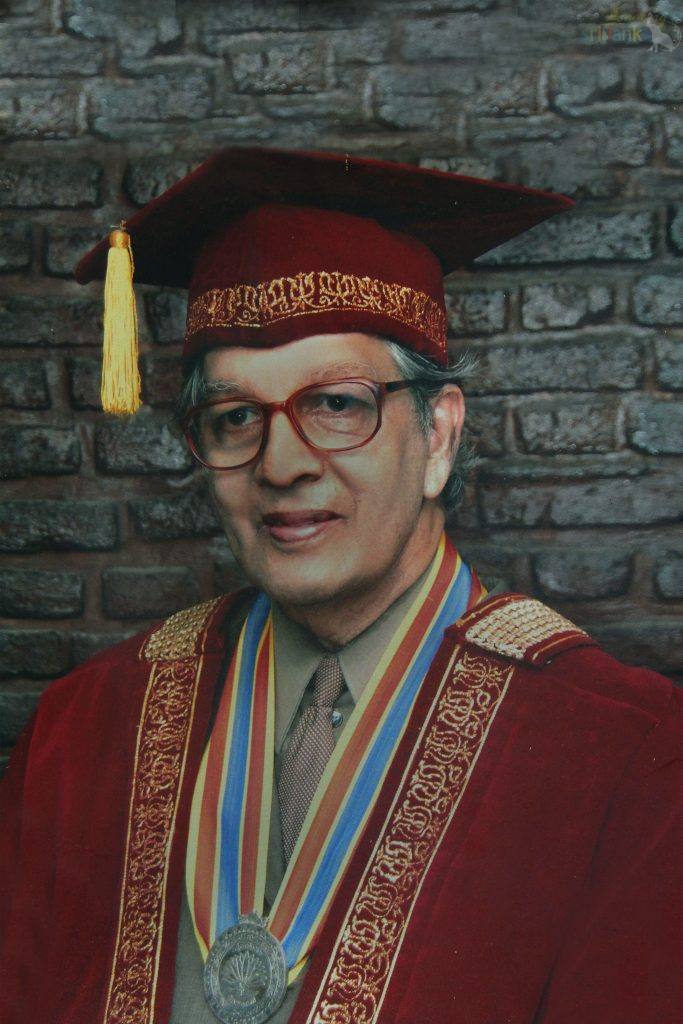A Tribute to a Giant – part 1

Dr. Roland Silva (1933-2020)
By Ama H.Vanniarachchy
Dr.Roland Silva was a man who changed the face of Sri Lanka’s heritage sector through his revolutionary and novel vision. Therefore, he is fondly remembered as a ‘Giant’ and a ‘Genius’ of the heritage sector by heritage practitioners in Sri Lanka.
As we commemorated him on the 5 June 2021 on his 88th birthday anniversary, it is the right moment to halt for a moment and observe things in retrospect about the condition of Sri Lanka’s heritage sector; to see if it is in the alignment with Dr.Roland Silva’s vision; to rethink if we are truly following the path paved by him or are we straying.
Therefore, a rather in-depth and unbiased analysis of the current situation of Sri Lanka’s heritage sector is felt like a timely requirement, which should be followed up by a sustainable plan for safeguarding the future of the local heritage sector. Such an act would be the best tribute to Dr.Roland Silva. As we will be observing the Archaeology week starting from the 7 July, it would be another moment to rethink, refresh and re-correct the many flaws in the local heritage sector starting from the dysfunctional and highly politicized two main institutes, the Central Cultural Fund and the Department of Archaeology.
A revolution genius
Dr.Roland Silva revolutionized the local heritage sector and almost all of those who are in the local heritage sector today are walking on the path paved by Dr.Roland Silva. For this, he also brought a series of new institutions and improved their existence. Most of the senior professionals in the discipline today were trained by him. As the CCF was founded by him, the entire staff of this institute is indebted to him. In that sense, he not only contributed to safeguarding the cultural heritage of the country but also to secure the future of many.
His vision, his work, and his efforts secured the heritage sector of Sri Lanka as no one ever did. He is the founding head and founding visionary of both CCF and ICOMOS and the National Trust. Served as the Archaeological Commissioner at the Department of Archaeology where he also brought in many changes and as the founding Director-General of the CCF, Dr.Roland Silva also played a vital role in establishing the architectural and archaeological education and the practice through the creation of new institutions such as the Post Graduate Institute of Archaeology (PGIAR) and also the Course on Architectural Conservation of Monuments and Sites of the University of Moratuwa.
My first encounter with Dr.Roland Silva
I first met Dr.Roland Silva on a Thursday evening in the little room on the first floor, next to the auditorium at the Post Graduate Institute of Archaeology (PGIAR). That was when I joined the National Trust, in 2016. I knew he was a genius and a giant in the heritage sector and have read and studied his work. But what took my heart was his humbleness, kindness, and the warm-welcoming nature he showed to junior amateurs like us. Since then I never missed any National Trust meeting just because I wanted to listen to the interesting stories Dr.Roland had to share about history and archaeology and his adventurous life. For me, they were insightful words of wisdom.
Although my time of knowing Dr.Roland Silva was very brief, just three years to be precise, I was determined to pay tribute to this genius and great archaeologist during his birth month. But, I am nobody to talk about Dr.Roland Silva, a giant and a great visionary. Therefore, I spoke to a few senior heritage practitioners who closely worked with Dr.Roland Silva and who had contributed immensely to implementing Dr.Roland’s vision of safeguarding the country’s cultural heritage.
The story we present to you is not merely the life story of Dr.Roland Silva. This is about his great vision and how he implemented it, and about the present and future of Sri Lanka’s heritage sector, and how we all as legacy bearers should pay tribute to him by following his vision.
Dr.Gamini Wijesuriya, senior archaeologist and his successor as the head of conservation in the Department of Archaeology, a position he held from 1960 to 1983, and one of the closest colleagues of Dr.Roland Silva explained that the great service of Dr.Roland Silva can be decoded under the following headings:
The vision/ Philosophy for heritage
The notion of living heritageSelf-sustenanceHuman resourcesMultidisciplinary approachPrinciples/ processes/ practices
Placing Sri Lankan heritage on the world Map (Cultural triangle project and the World Heritage List) Improving the institutions/ creating New Institutions/ institutional culture Internationalism
The vision/ Philosophy for heritage
Dr.Roland Silva’s vision and philosophy for heritage were unique; it was strategic, long-term, and empowered by far-sighted wisdom. It was broad; not confined to the borders of the island only nor merely to his period of service or authority.
The notion of living heritage
From the outset, Dr.Roland Silva attributed the notion of living heritage to understanding and conceptualizing Sri Lanka’s heritage and acted accordingly during its conservation and management process. He tried to maintain the balance between science and religion in his work on the restoration of religious buildings, particularly the stupas. For instance, when he restored, he left certain portions of the early phases of the stupas for the devotees to touch and respect. In his mega project, cultural triangle, he applied this philosophy and stated that once restored ‘sites will have to be considered as religious sites with monks and pilgrims playing their part in religious establishments’. In the conservation of religious buildings, he consulted the religious leaders closely. His famous statement to all staff working at religious sites as these are all ‘සාංඝික දේපොල’ therefore to respect accordingly. One of his well-known mottos was ‘what is needed is LOVE and not LAW for managing our heritage.
Key to the success of implementing this philosophy was the participatory approach involving religious leaders, owners, local community, and other stakeholders for sustainable conservation and management which he followed diligently.
Self-sustenance
One of his mottos was ‘culture is a gold mine awaiting excavation’ which he applied for the self-sustenance of the heritage sector. In order to keep going with the conservation, management, and research work in the country’s heritage sector, Dr.Roland Silva introduced the Cultural Triangle project and the Central Cultural Fund to implement the project while raising much-needed funds. Under this project, the income generated by the heritage sites was utilized for their management.
Knowing very well that Sri Lanka’s treasury is neither interested nor capable of funding a project of such magnitude, and realizing that UNESCO also has limited financial resources, the Central Cultural Fund, a unique institution, not only raises funds through gate collection of visitors to the heritage sites but for the successful implementation of the project by evolving a specific mechanism.
Human resources
Realizing that it is not possible to protect and manage the cultural heritage of the country with the then-existing number of human resources, Dr.Roland Silva, worked towards expanding the number of professionals as well as producing quality, well-trained professionals. Outsourcing of heritage activities was started for the first time. In order to promote the development of human resources and to retain them long-term only, he started building up new institutions including training institutions.
Multidisciplinary approach
It was Dr.Roland Silva who first introduced a multidisciplinary approach to the heritage sector of Sri Lanka. Leading from the front, he mustered the professional support of engineers, surveyors, scientists, dating specialists, art historians in addition to archaeologists, and architects to execute heritage programs with a multi-disciplinary approach, for the first time in Sri Lanka, and perhaps in South Asia.
Principles/ processes/ practices
He also standardized the conservation practices by developing several methodological approaches and frameworks for different types of monuments and historic materials, and they are still being followed by the conservation professionals in Sri Lanka.
He developed a vision and finally realized how to implement heritage projects with a holistic approach for meaningful comprehension of heritage, rather than excavating and conserving isolated monuments depending on the limited budgetary provisions released by the treasury from time to time.
Making of a genius…
Born at Giriulla in 1933 and educated at St. Joseph’s College, Colombo, young Roland Silva’s choice of studying architecture was a surprise to his parents, whose intention was to make him an accountant to run their family business. During his training at the prestigious AA School of Architecture in London from 1954 to 1959, he was not only interested in how to design buildings but also to understand the meaning of the heritage buildings that were created by architects and builders of the distant past. While studying architecture, he somehow found time to follow and successfully complete the Postgraduate Diploma in Indian Archaeology at the Institute of Archaeology at the University of London in 1958. Even at a relatively young age, Roland Silva demonstrated his skills in multi-tasking, which later became a hallmark of his illustrious career. After qualifying as an architect at AA School, he came back to Ceylon and became an Associated Member of the Ceylon Institute of Architects in 1960 and the Royal Institute of British Architects in 1962. Instead of beginning a lucrative career in architecture, Roland Silva chose a career in the heritage sector by joining the Department of Archaeology as Assistant Commissioner (Architect) in 1960 with the responsibility of taking care of Sri Lanka’s monuments and sites. While working at the Department of Archaeology, he went on to obtain a Postgraduate Diploma in Conservation of Monuments from the University of Rome in 1968 and a Doctor of Philosophy from the prestigious University of Leiden in the Netherlands in 1988.
His office space spelled out his humbleness and work efficiency…
The Head Office building of the CCF at Bauddhaloka Mawatha in Colombo 7, which he designed, also displays a highly economical use of space. Roland Silva’s own office room in this building had an exceptionally small space, only a little larger than that of a business class space for a passenger within an aircraft. He used a small table and a basic chair made out of rubber wood. There was no door to his room and no locks for the drawers of his table, reflecting amply his transparency, openness, accessibility and after all, his humble attitude toward serving the country. On the other hand, his tiny room and the building as a whole sent a strong message to the public, specifically to the international donors at that time, how Roland Silva and his CCF were making efforts to cut down the operational costs to maximize funds for heritage activities in the field.
To be continued…
Picture courtesy – Dr.Roland Silva’s family album
Special thanks to Dr. Gamini Wijesuriya, President, ICOMOS Sri Lanka.
Dr. Nilan Cooray, conservation and management specialist / Vice President, ICOMOS Sri Lanka
Information source – Roland Silva; a genius of an era by Dr.Gamini Wijesruya, Dr.Nilan Coorey, and Jayatissa Herath. Published by ICOMOS Sri Lanka.
Dr. Roland Silva explaining about an artifact to Hon. E. L. B. Hurulle, the Former Minister of Culture
Dr. Roland Silva explains the conservation of the Jetavana Stupa to the Rev. Monks and Government Officials
Dr. Roland Silva on top of the dome of Jetavana Stupa with Dr. Siran Deraniyagala and British Archaeologist Richard Hughes
Young Dr.Roland Silva with his daughter
Young Dr.Roland Silva
Uncategorized, Central Cultural Fund, Dr. Roland Silva, Sri Lankan archaeology
